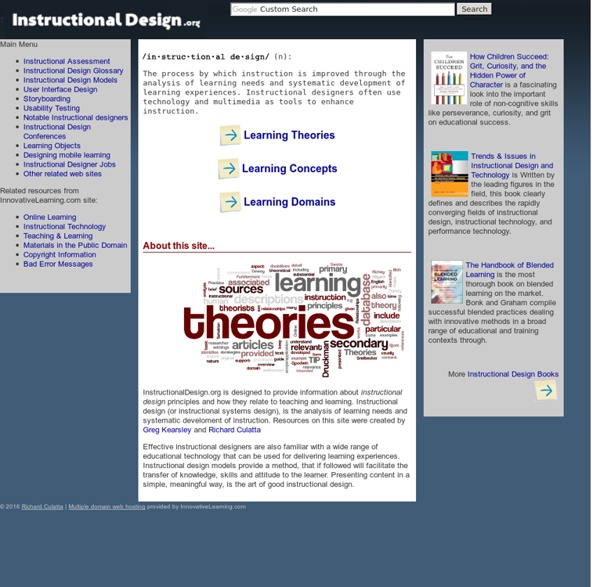



http://www.instructionaldesign.org/index.html
Related: LTTO • eLearningOnline Learning Online learning is a general term used to refer to learning experiences that are delivered via a computer network to learners in different physical locations. Online learning is also known as e-Learning, although that is somewhat of an ambiguous term since just about all learning has some level of "e" in it. In addition, we use technology to enhance our work and we don't call it "e-work". We also don't label other types of learning (for example we don't call reading a book "b-learning"). Therefore while eLearning and online learning are essentially the same thing, the term Online Learning is the preferred term.
5E Instructional Model for eLearning Preferred by NASA Custom eLearning development is one of the challenging as well as an interesting area for an instructional designer. Its major challenge lies in finding efficient and effective learning solutions that meet unique learning needs. In this blog, I will describe 5 E’s instructional model and propose important suggestions to implement it in eLearning. First, we will begin with a reference from NASA eClips which says… “NASA eClips™ supports the 5E constructivist learning cycle, helping students build their own understanding from experiences and new ideas.” Source: Instructional Development Timeline Robert Gagne (1916-2002) Education Yale, A.B. 1937Brown, Ph.D. 1940 Career Highlights Professor, Connecticut College (1940-49)Professor, Penn State University (1945-46)Director of Perceptual and Motor Skills Laboratory, U.S. Air Force (1949-58)Professor, Florida State University
Instructional Design Models Instructional Design Models Models, like myths and metaphors, help us to make sense of our world. Whether derived from whim or from serious research, a model offers its user a means of comprehending an otherwise incomprehensible problem. An instructional design model gives structure and meaning to an I.D. problem, enabling the would-be designer to negotiate her design task with a semblance of conscious understanding. Models help us to visualize the problem, to break it down into discrete, manageable units. The value of a specific model is determined within the context of use.
The eSalsa Project With a team of experts from ocean modelling and distributed computing we will tackle the problem of determining projections of future sea level changes due to changes in the North Atlantic ocean circulation. The innovative element is the use of an eddy-resolving ocean model, the Parallel Ocean Model (POP) to determine these sea level changes with an unprecedented level of detail (10 km resolution). The technical challenge is to integrate the ocean model under an ensemble of atmospheric forcing conditions for about 100 years such that also the uncertainties and extremes in sea-level changes can be determined. To realize these computations within the 3-year period of this project, the implementation of new distributed computing techniques in the POP model is essential, as is the use of state-of-the art accelerators such as GPUs. The project will be managed according to the Simulation Lab strategy which is very ambitious and will be transformative in the ocean-modelling field.
Learning theory: models, product and process Photo by Antenna on Unsplash Contents: introduction · what do people think learning is? · learning as a product · learning as a process · experience · reflective thinking · making connections · committing and acting · task-conscious or acquisition learning, and learning-conscious or formalized learning · the behaviourist orientation to learning · the cognitive orientation to learning · the humanistic orientation to learning · the social/situational orientation to learning · the constructivist/social constructivist orientation to learning · further reading · references · how to cite this article See, also, What is education? Over the last thirty years or so, ‘learning’ has become one of the most used words in the field of education. Adult education became lifelong learning; students became learners, teachers facilitators of learning; schools are now learning environments; learning outcomes are carefully monitored.
Create and Manage Student Blogs in 5 Simple Steps – The Edublogger We’re seeing increasing numbers of educators use blogs as digital student portfolios, where students showcase their work and share their learning, throughout their school life. Why? Studies have found that the effort of communicating to someone else forces you to pay more attention and learn more (Clive Thomspon).When students were asked to write for a real audience in another country, their essays had better organization and content than when they were writing for their teacher (Clive Thomspon).Digital student portfolios can be used for application to colleges, Universities or for applying for jobs.We all have increased motivation when we feel personal ownership. You see greater improvements in student learning and literacy skills when each student has their own student blog. Blogs allow students to easily transfer the digital student portfolio to their own personal space as all standard blogging platforms allow you to easily transfer content between platforms using export/import.
IDKB - Models/Theories Learning happens when a correct response is demonstrated following the presentation of a specific environmental stimulus Learning can be detected by observing an organism over a period of time Emphasis is on observable and measurable behaviors